Piriformis syndrome is a type of neuromuscular disorder which is fairly common and occurs when a person’s piriformis muscles compresses their sciatic nerve. This muscle is band-like and flat and found within the buttocks close to the hip joint at the top. The muscle is involved in lower body movements where it stabilizes a person’s hip joint while rotating and lifting your thigh from the body. It is very common for patients with this condition to describe feeling acute buttock tenderness as well as pain resembling sciatica along the back of their thighs, calves, and feet. Common symptoms include a reduction in the range of motion of the hip joint, increase in pain following prolonged sitting, pain when climbing inclines or stairs, sciatica-like pain, and a dull ache of the buttocks.
Symptoms will frequently worsen following prolonged running, walking, or sitting and will be relieved somewhat after a patient lies down on their back. There are also other piriformis syndrome treatment methods.
Piriformis Syndrome Treatment
Your doctor will work with you to select the right one for you based on whether sciatica-like pain is present, and severity of other symptoms.
Ice and Heat Therapy for Piriformis Syndrome
Ice and heat therapy are some of the easiest ways to treat piriformis syndrome.
- Ice Packs and Ice Massage: When pain begins, lie down on your stomach in a comfortable position. Put an ice pack on top of the painful area for 20 minutes and repeat this each 2 or 4 hours as needed. You can also ask someone to massage the area using an ice cube. Never apply ice directly to the skin for over 8 to 10 minutes as there is a risk of ice burn. You can also apply ice right after painful activity.
- Heat Therapy: It sometimes helps to alternate heat and cold. Lie on your stomach with the heating pad on top of the area of pain. Leave it in place for no more than 20 minutes and never fall asleep during heat therapy.
Physical Therapy
Part of piriformis syndrome treatment should always include stretching the piriformis muscle while strengthening the adductor muscles and the adductor. You can combine this with Gebauer’s spray, thrust, muscle energy, myofascial, and soft tissue techniques. You will want to stretch the piriformis muscle at least daily and may need to stretch the other buttock muscles and groin as well for a balanced joint.
1. Stretching Exercise
 Outer hip stretch: Lie down on your back, bending the knee of your leg you want to stretch. Use your opposite hand and pull the knee to the side. You will feel it in the buttocks and hips. Hold the stretch 20 or 30 seconds, with 3 to 5 reps and 3 times each day.
Outer hip stretch: Lie down on your back, bending the knee of your leg you want to stretch. Use your opposite hand and pull the knee to the side. You will feel it in the buttocks and hips. Hold the stretch 20 or 30 seconds, with 3 to 5 reps and 3 times each day.
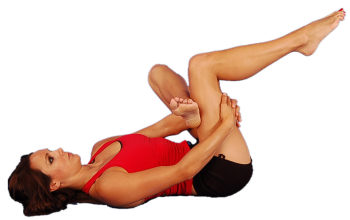 Piriformis stretch: Lie on your back with both knees bent and your feet on the floor. Take the outer foot from the leg you want to stretch and put it on top of your other leg’s lower thigh or knee. Hold behind your thigh, pullingthe knee towards your chest. You will feel it in your buttock. Hold it 30 seconds, doing 3 to 5 reps for 3 times daily. An alternative is to stand and put your knee under and across your body on a table before leaning forward.
Piriformis stretch: Lie on your back with both knees bent and your feet on the floor. Take the outer foot from the leg you want to stretch and put it on top of your other leg’s lower thigh or knee. Hold behind your thigh, pullingthe knee towards your chest. You will feel it in your buttock. Hold it 30 seconds, doing 3 to 5 reps for 3 times daily. An alternative is to stand and put your knee under and across your body on a table before leaning forward. Long adductor stretch: These muscles connect by your knee and require a straight leg to stretch. You can stand or sit to stretch them.
Long adductor stretch: These muscles connect by your knee and require a straight leg to stretch. You can stand or sit to stretch them.
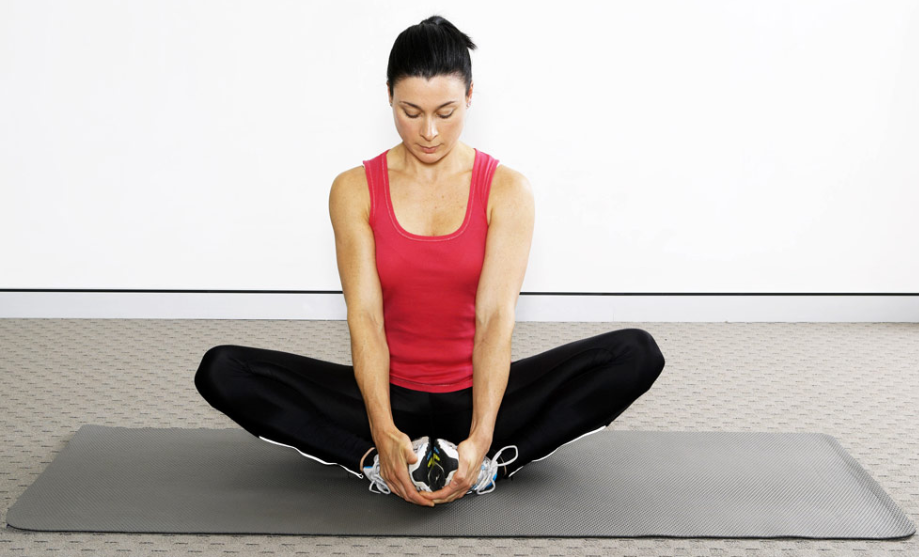 Short adductor muscle stretch: To stretch this muscle, your knees must be bent. Sit down on the floor with the soles of the feet together. Apply gentle pressure downward with your elbows to increase stretching. You should feel it on the inner thigh. Hold 30 seconds, repeating 3 to 5 times and 3 times each day.
Short adductor muscle stretch: To stretch this muscle, your knees must be bent. Sit down on the floor with the soles of the feet together. Apply gentle pressure downward with your elbows to increase stretching. You should feel it on the inner thigh. Hold 30 seconds, repeating 3 to 5 times and 3 times each day.
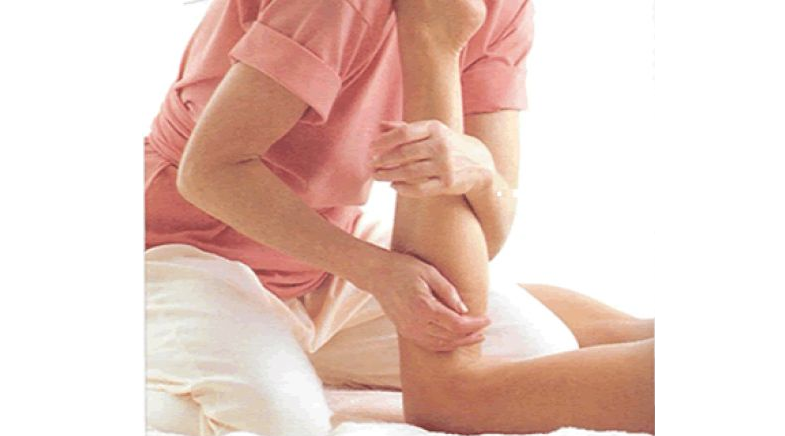 Muscle energy technique: Lie down on your front and ask a partner to rotate your bent leg outwards. You should then apply 25 percent effort to try to bring your leg back vertically. Hold 10 seconds, relax, and move the leg further, repeating for 30 seconds. Only do this with a trained therapist.
Muscle energy technique: Lie down on your front and ask a partner to rotate your bent leg outwards. You should then apply 25 percent effort to try to bring your leg back vertically. Hold 10 seconds, relax, and move the leg further, repeating for 30 seconds. Only do this with a trained therapist.
2. Strengthening Exercise
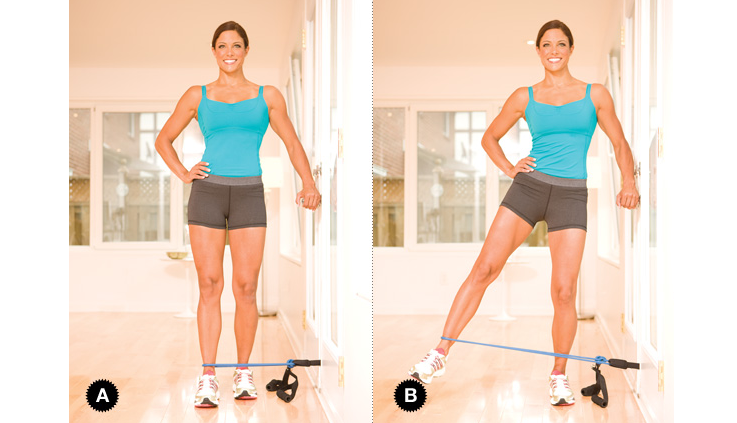 Resistance band abduction: Stand with a band attached to a fixed object on one side and your ankle on the other. Move your leg away from your body while it is straight before returning to neutral. Repeat 15 times.
Resistance band abduction: Stand with a band attached to a fixed object on one side and your ankle on the other. Move your leg away from your body while it is straight before returning to neutral. Repeat 15 times.
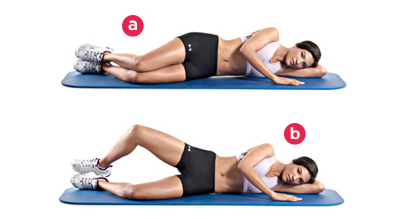 Side lying clam exercise: Lying on the side, placing your problem hip on top. Bend your knees so your feet line up with the spine. Keeping your ankles together, raise your top knee from the bottom. Do 15 reps.
Side lying clam exercise: Lying on the side, placing your problem hip on top. Bend your knees so your feet line up with the spine. Keeping your ankles together, raise your top knee from the bottom. Do 15 reps.
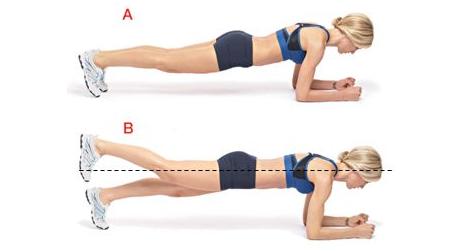 Hip extension exercise: Get on all fours, slightly shifting weight off the leg you will work. Keep your knee bent and raise your knee off the floor, lifting your foot sole to the ceiling. Lower and repeat 15 times.
Hip extension exercise: Get on all fours, slightly shifting weight off the leg you will work. Keep your knee bent and raise your knee off the floor, lifting your foot sole to the ceiling. Lower and repeat 15 times.
Watch this video to learn more about exercises for sciatica as piriformis syndrome treatment.
3. Sports Massage
- Effleurage of the Leg: Use your hands to firmly and lightly upwards going from the ankle to the entire leg, then the buttocks. Then go down the outside of your leg. Aim to cover as much surface as possible. Do this 5 or 10 times.
- Petrissage on the buttocks: Follow a circular pattern with firm kneading movements, working to manipulate and move the muscles using your hands.
- Stripping of the piriformis: Apply firm and sustained pressure along the muscle using the heel of your hand. You can also do this using the elbow.
Medications
In cases where manual piriformis syndrome treatment is not enough, you may use acupuncture or trigger point injection featuring botulinum toxin type A, steroids, or lidocaine hydrochloride. Surgical decompression is the final option.
Acetaminophen and nonsteroidal anti-inflammatory drugs can help. Muscle relaxants also provide results. Side effects include dry mouth, dizziness, and drowsiness. Although more research needs to be done, narcotic analgesics may also be used as a short-term solution. Side effects include sedation, gastrointestinal upset, and constipation. Addiction is also a concern.
Local steroid injections may have anti-inflammatory effects in certain patients. Infection is most common of complications.
Surgery
If the pain cannot be relieved by all the previous methods, it is when the surgery is needed. Surgery as piriformis syndrome treatment is fairly easy. The surgeon cuts the muscle tendon at insertion by the trochanter of your femur to relax it. They then close it with skin glue and dissolvable stitches, when combined with sacroiliac surgery, there will be an extra incision. There is also a surgical option that will directly explore the nerve.
Potential issues with surgery include the area being more sensitive to pain, the muscle not becoming relaxed immediately, or it having uncomfortable spasms. Wounds will heal within a few weeks, but the piriformis and nearby issues might take longer.
